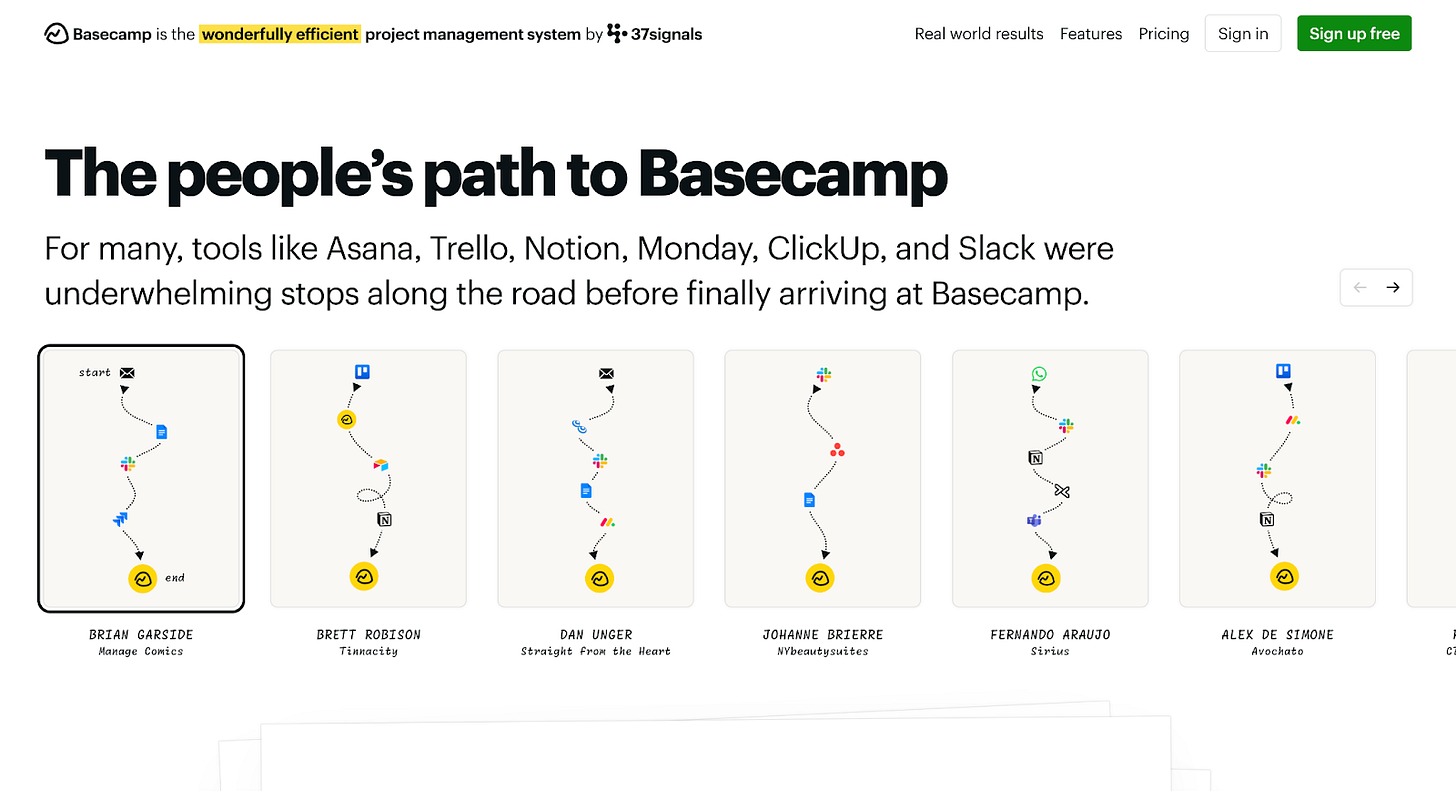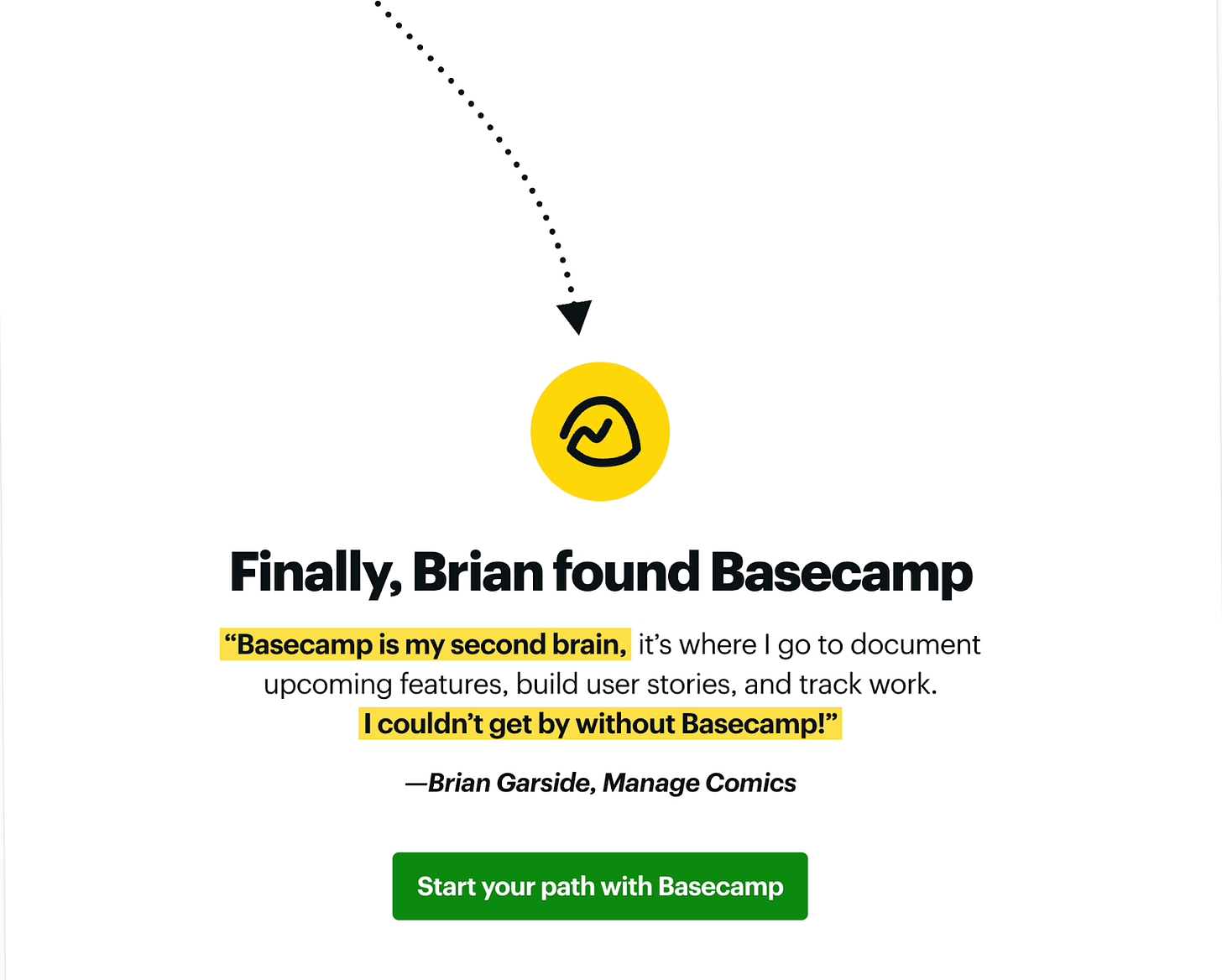Basecamp Paths
Beyond comparison pages: What Basecamp’s Paths teach us
👋 Hey, I’m George Chasiotis. Welcome to GrowthWaves, your weekly dose of B2B growth insights—featuring powerful case studies, emerging trends, and unconventional strategies you won’t find anywhere else.
A few weeks ago, I was on Basecamp’s website.
I was always impressed with their ability to differentiate and communicate very simple messages (read: common sense) in a very bold way.
At some point, I visited a page I never saw before.
They call this page ‘Paths,’ and it’s a new approach to comparative marketing.
What are Paths?
Basecamp’s Paths are visual representations of (their) users' paths to Basecamp.

Each path visually represents the tools people use before they ‘arrive’ at Basecamp.
At the end of every path, there’s a testimonial from the user (who took that path) and a CTA for people to ‘Start their path with Basecamp.’

There are several things marketers can learn from this, but before I unpack it for you, let’s take a step back and talk about comparative marketing for SaaS companies for a minute.
Comparative marketing for SaaS companies
For most SaaS companies, comparative marketing means one thing:
Comparison pages for their direct competitors, usually as a blog post or a landing page.
Roughly speaking, there are three comparison types:
{your product} vs {your competitor}
{your competitor} vs {your competitor}
{your product} vs {your competitor} vs {your competitor}
The first two are 2-way comparisons, while the third is 3-way.
Here’s an example of the second type by Monday.com:

These comparisons are intended to help buyers in the commercial investigation phase of the customer journey (i.e., when they’re product aware).
This is to say that they play an essential role in the SaaS buying process.
The problem is that if you’ve been in this space for a while, you’d know that there’s little-to-no creativity in terms of comparison pages.
On top of that, most of these pages are usually positively biased on behalf of the company that produced the page. (Which, to a certain extent, makes sense.)
Basecamp does things differently.
What can we learn from Basecamp’s Paths?
Basecamp operates in a mature, crowded category (i.e., project management software).
This means that Basecamp buyers or people using their tool through a free-forever plan know and most likely use or have used other tools in that category.
It’d be wrong to assume that Basecamp’s users or customers had never used other tools before joining Basecamp.
Basecamp knows that because they talk to their customers.
There are several things we can learn from this:
1) Start naming and talking about your competitors
I talk to several companies who are reluctant to name their competitors and talking about them.
When I say ‘talking,’ I don’t mean creating comparison pages that try to prove that you’re better in every comparison point.
That’s not only impossible, but people can sense the bias on the page.
What I mean is naming your competitors and start talking about them in an unbiased way that adds value to the decision-making process.
2) Your competitors aren’t always who you think they are
Very often, marketers make assumptions as to who their competitors are.
As I wrote in a previous post, your biggest competitor is usually the status quo.
In Basecamp’s case, that may be endless Slack threads, hard-to-find Google Docs, or hours spent on Zoom calls.
Identify the status quo, give it a name, and attack it.
To identify it, you’ve got to talk to your customers.
Audience research tools won’t cut it here.
3) Comparison pages aren’t enough
Having comparison pages is level one.
You should have it, even if you think that you shouldn’t.
Especially in more mature categories where buyers know the most prominent players, you should use comparison pages to position yourself and tell your part of the story.
Going beyond that is understanding what solutions people use before coming to you or what other solutions they use after coming to you. (In conjunction with your solution.)
Similar to what Basecamp did with Paths, you need to talk about these buyer journeys in a way that makes people feel that you 'get it' and that you know exactly what they're going through.
Final thoughts
Comparative marketing can be a powerful tool in a marketer’s hands.
Basecamp is showing us how to do it right (or at least do it differently).
Comparison pages are important, but they’re table stakes.
To win this year and beyond, you’ve got to go beyond the comparison types we saw earlier.
Just like Basecamp did.


Good one!